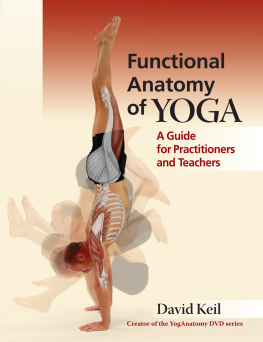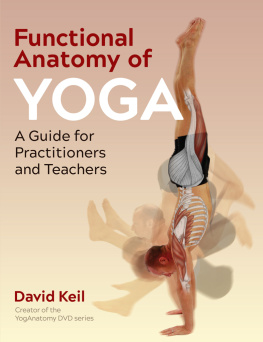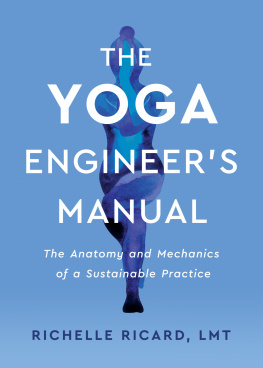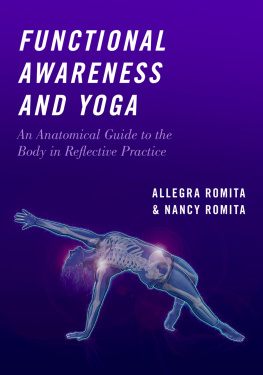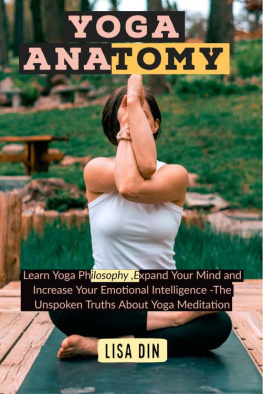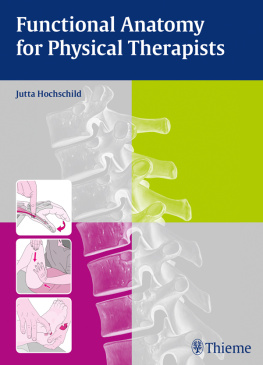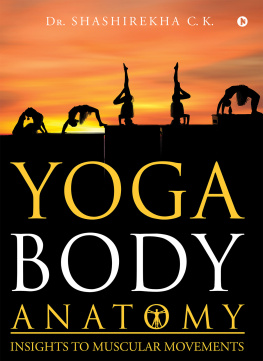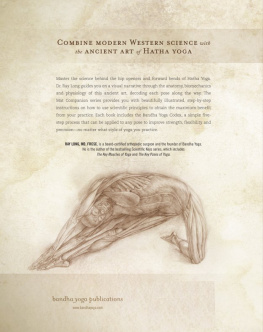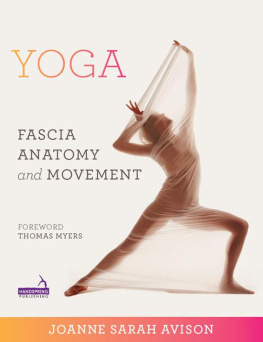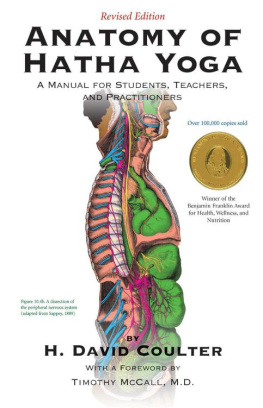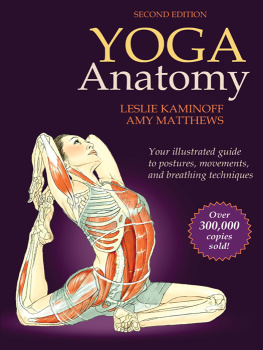David Keil - Functional Anatomy of Yoga
Here you can read online David Keil - Functional Anatomy of Yoga full text of the book (entire story) in english for free. Download pdf and epub, get meaning, cover and reviews about this ebook. publisher: Lotus Publishing, genre: Religion. Description of the work, (preface) as well as reviews are available. Best literature library LitArk.com created for fans of good reading and offers a wide selection of genres:
Romance novel
Science fiction
Adventure
Detective
Science
History
Home and family
Prose
Art
Politics
Computer
Non-fiction
Religion
Business
Children
Humor
Choose a favorite category and find really read worthwhile books. Enjoy immersion in the world of imagination, feel the emotions of the characters or learn something new for yourself, make an fascinating discovery.
- Book:Functional Anatomy of Yoga
- Author:
- Publisher:Lotus Publishing
- Genre:
- Rating:3 / 5
- Favourites:Add to favourites
- Your mark:
- 60
- 1
- 2
- 3
- 4
- 5
Functional Anatomy of Yoga: summary, description and annotation
We offer to read an annotation, description, summary or preface (depends on what the author of the book "Functional Anatomy of Yoga" wrote himself). If you haven't found the necessary information about the book — write in the comments, we will try to find it.
Functional Anatomy of Yoga — read online for free the complete book (whole text) full work
Below is the text of the book, divided by pages. System saving the place of the last page read, allows you to conveniently read the book "Functional Anatomy of Yoga" online for free, without having to search again every time where you left off. Put a bookmark, and you can go to the page where you finished reading at any time.
Font size:
Interval:
Bookmark:

Functional
Anatomy of Yoga
A Guide for
Practitioners and Teachers
David Keil

Copyright 2014, 2017 by David Keil. All rights reserved. No portion of this book, except for brief reviews, may be reproduced, stored in a retrieval system, or transmitted in any form or by any meanselectronic, mechanical, photocopying, recording, or otherwisewithout the written permission of the publisher. For information, contact Lotus Publishing.
First published in 2014, and redesigned in 2017 by
Lotus Publishing
Apple Tree Cottage, Inlands Road, Nutbourne, Chichester, PO18 8RJ
Anatomical Illustrations Amanda Williams and Emily Evans
Photographs Jose Caban
Text Design Medlar Publishing Solutions Pvt Ltd., India
Cover Design Paula Morrison
Printed and Bound in India by Replika Press
MEDICAL DISCLAIMER: The following information is intended for general information purposes only. Individuals should always see their health care provider before administering any suggestions made in this book. Any application of the material set forth in the following pages is at the readers discretion and is his or her sole responsibility.
British Library Cataloguing-in-Publication Data
A CIP record for this book is available from the British Library
ISBN 978 1 905367 46 7
Contents
Acknowledgments
T here are many people who have been a part of making this book possible. First and foremost is my wife who has put up with me quitting the task, picking it up again, and all the complaining that happened until I finally got it done. Secondly, is my publisher, who is extremely patient, and put up with me going way over the deadline. Third, is my final editor Eryn Kirkwood, who did a fantastic job of helping me convey the subject clearly.
The book wouldnt be in your hands right now if a series of events hadnt happened in just the right order at just the right time.
I must say a very special thanks to Iris Burman and the staff that supported me at Educating Hands School of Massage in Miami, Florida. Without their support, guidance and ultimately tossing me into the deep end to start teaching, I would not have honed my skills as a teacher. It was also at Educating Hands that I met my first mentor in bodywork, Nick Chitty. His guidance, friendship, and mentoring propelled my work to the next level.
My very first anatomy workshop for yoga students would not have happened if not for Karen Schachter who in 2000 asked me to teach a group of her friends at a local yoga studio. My very first hosts were Ryan Spielman and Marisa Gallardo at Yoga Grove in Miami, Florida.
The real work of understanding my anatomy was through the practice of yoga. For that I had to meet John Scott and his wife Lucy Scott in 2001. If I had not met them I would never have made it to Mysore, India. It was there that I met Sri K. Pattabhi Jois and his grandson Sri R. Sharath. It was John and Lucys guidance of my practice and the discipline that I found in Mysore that pushed me deeper into my own practice. This depth and focus helped me to understand my anatomy, especially as it related to yoga.
Beyond that, there have been countless studios that have warmly welcomed me to be part of their teacher training programs and present anatomy to their students. All of them have helped to get this book into your hands as well. Without the questions, comments, or looks of utter confusion from these students, I would not have refined my teaching. After all, we always grow through relationship. With great thanks to all of these students, I appreciate your feedback and interactions.
Last, but certainly not least, is the assistance from everyone here at Yoganatomy.com. A very special thank you to, Christine Wiese, Amy Dolan, Aaron Segall, and Guy Andefors.
Foreword
I n 2001 David arrived at our yoga studio in Penzance, Cornwall, UK, to work with Lucy and myself, in developing his Ashtanga Vinyasa yoga practice. David had been practicing asana (yoga postures) for some time, but it was obvious that he was not breathing or using bandha (subtle body controls) correctly or efficiently; he needed to refine his relationship and the balance between sthira (steady, still, and firm foundation) and sukha (good space). For the yogin (one who practices yoga), understanding sthira and sukha deepens the understanding of the relationship between posture, gravity, and breath and for the anatomist who practices asana , discovering sthira and sukha will bring understanding of the structure, function, breath and movement of the human body to a whole new level.
When we met David so many years ago, his immense understanding of anatomy and experience gained from teaching and working in the field of massage was also evident. He presented a short yoga anatomy workshop at our studio for local and visiting students who were practicing with Lucy and I. His animated delivery emphasized how remarkable the human body is. At the end of the evening, a local doctor who was participating said that in all her years of medical training and anatomy classes, this one session with David brought the body alive for her. Lucy, also an experienced body worker and massage therapist, was so impressed that she went straight to David and invited him to teach the anatomy for our yoga teacher trainings.
That evening was the beginning of a mutual journey of growth, with Lucy, David, and myself together exploring, discovering, having insights, and gaining first hand a new appreciation for this amazing body we inhabit. This journey with David will continue for years to come, and Im sure this will be the first of many books he will write.
The information in this book has not come from researching other books but from deep exploration on the yoga mat. David does not reduce the body to mere parts. For practical reasons, the work is divided into chapters, but at all times, David maintains a wider perception, holding the body as a unified living, breathing, moving organism. He takes anatomy to a whole new level.
As with other anatomy texts, David references body parts with anatomical words and descriptions; however, he goes further. Using his own experience with yoga asana , putting his own body into the many gravity-defying structures, he creates an understanding for you, the reader, in everyday language. This book is a bridge across the gap between the professional academic and the self-exploring yoga student. You, too, will gain a personal understanding and insight by taking Davids gems of wisdom to your yoga mat, and through your own personal practical exploration, will connect all separated parts into one whole functioning and breathing body, alive steady in asana sthira/sukha .
It is an honor and a pleasure to write a foreword to this exploratory journey into the functioning of the physical body. When I read through Davids draft, I could hear his voice, the complexity yet simplicity of the presentation. It felt as though I was present in one of his workshops, eager to be led by David through the practical anatomical exercise on the yoga mat. This book is a journey of deep exploration that will enhance each individuals understanding of what it really means to inhabit a body that not only stands in anatomical neutral, samasthitih , but also moves with the breath to create asana. A body that shape shifts towards the postural understanding of our bodies, tension free, relaxed, still, and steadygracefully moving in space, mastering the relationship of posture, breath, and gravity.
Next pageFont size:
Interval:
Bookmark:
Similar books «Functional Anatomy of Yoga»
Look at similar books to Functional Anatomy of Yoga. We have selected literature similar in name and meaning in the hope of providing readers with more options to find new, interesting, not yet read works.
Discussion, reviews of the book Functional Anatomy of Yoga and just readers' own opinions. Leave your comments, write what you think about the work, its meaning or the main characters. Specify what exactly you liked and what you didn't like, and why you think so.

